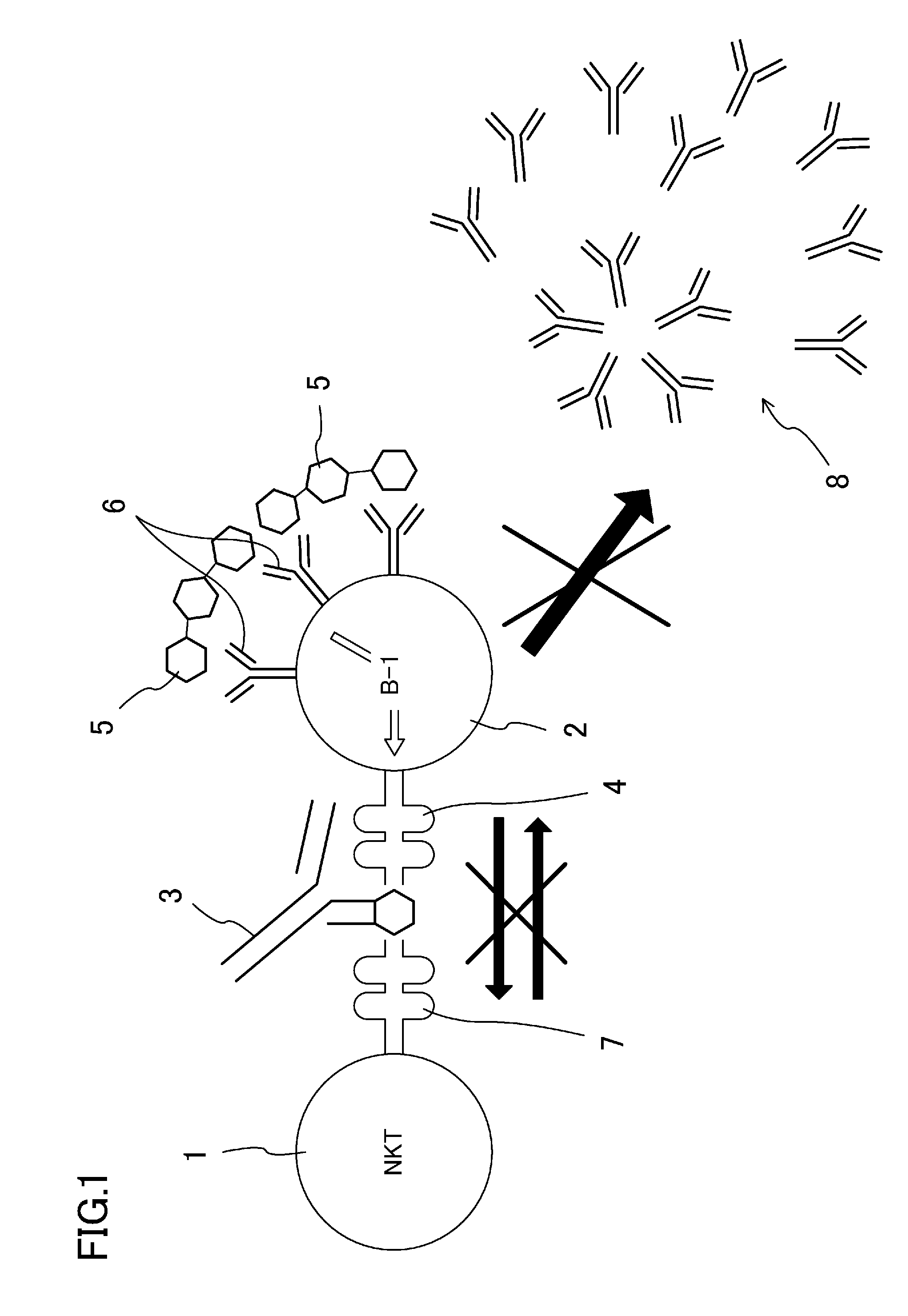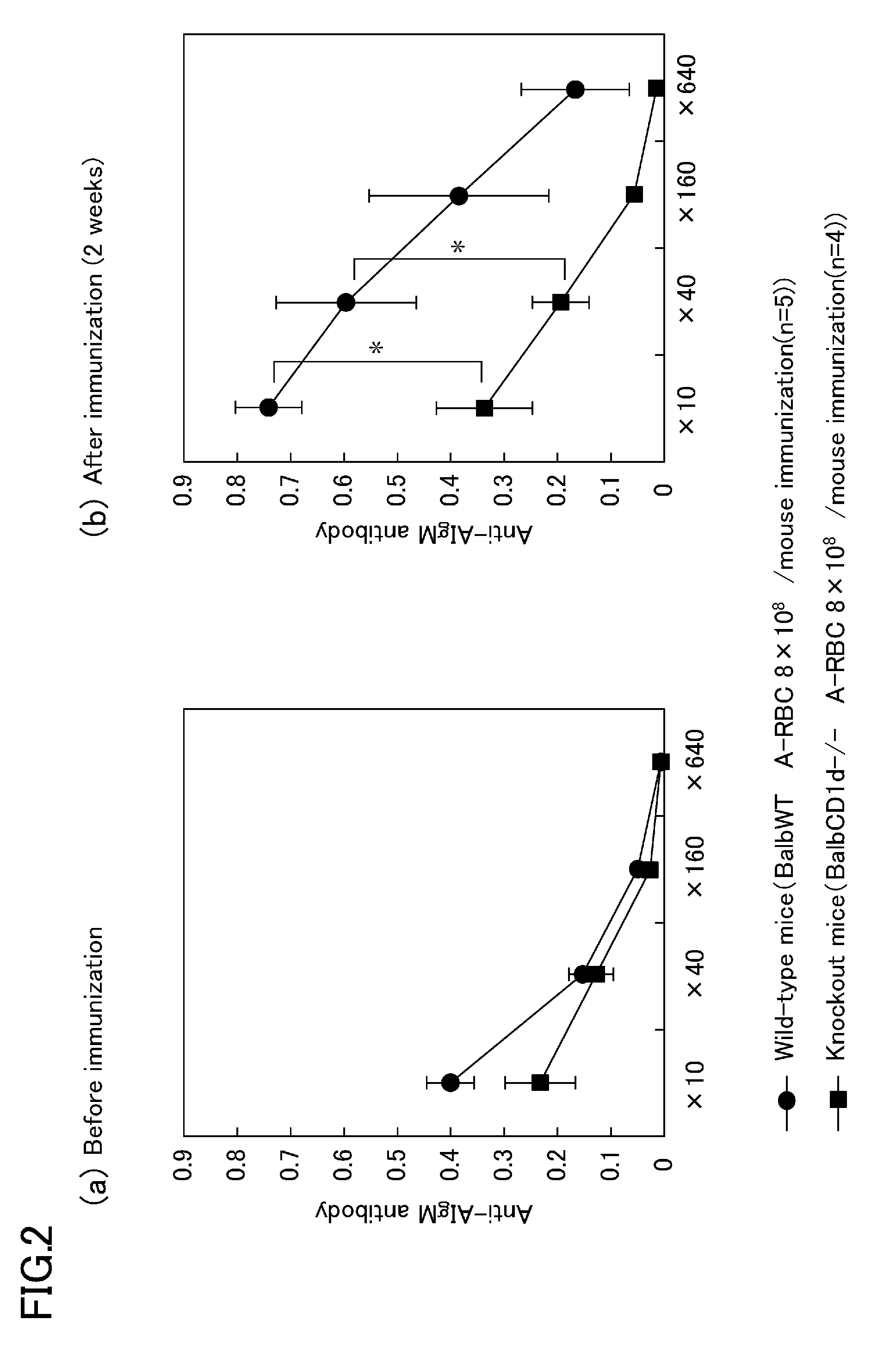Antibody-mediated rejection inhibitor
a technology of antibody-mediated rejection and inhibitors, which is applied in the field of antibody-mediated rejection inhibitors, can solve the problems of antibody-mediated rejection serious problems, serious declines in immune functions, and serious shortage of organ donors, and achieve the effects of inhibiting antibody production, inhibiting antibody production, and effectively inhibiting
- Summary
- Abstract
- Description
- Claims
- Application Information
AI Technical Summary
Benefits of technology
Problems solved by technology
Method used
Image
Examples
first example
[0058]To analyze the influence of NKT-cells on production of antibodies against blood group carbohydrate chain antigens, Balb / c CD1d− / − mice (which lack CD1d as a ligand for iTCR and known to show a significant decrease in NKT-cells; knockout mice, n=4) and comparative Balb / c wild-type mice (n=5) were immunized with human group A red blood cells (8×108 / mouse), production of anti-blood group A antibodies were measured by ELISA.
[0059]The human blood group A red blood cells were immunized in the following manner. Blood is collected from blood group A healthy volunteers, twice washed in PBS, and diluted to 8×108 / ml. Then, 1 (one) ml of this diluted cells were administered in the abdominal cavities of mice, and twice immunized at a 1-week interval.
[0060]Detection of anti-blood group A antibody titers by ELISA was conducted in the following manner. Polystyrene 96-well flat-bottom plates (costar) were coated at 4° C. for 8 hours with 5 μg / ml of A-bovin serum albumin (BSA) (Dextra), or 5 μg...
second example
[0065]To analyze the influence of NKT-cells on production of antibodies against general peptide antigens, the knockout mice and Balb / c wild-type mice (MHC haplotype d) were immunized with thymocytes (20×106 / mouse) of C57BL / 6 wild-type mice (MHC haplotype b), and the production amount of anti-allo-MHC antibodies was measured with a flow cytometer (n=6, untreated group for comparison: n=3).
[0066]Allo-MHC antigens were immunized in the following manner. Thymi of C57BL / 6 wild-type mice were extirpated, and mashed with dishes. From the resultant thymi, red blood cells were removed with ACK lysing solution (155 mM NH4C1, 10 mM KHCO3, 1 mM EDTA-2Na, and PBS, pH 7.4), and thymocytes were isolated, and diluted to 20×106 / ml with a 199 medium. Then, 1 (one) ml of the diluted thymocytes were administered in the abdominal cavities of mice, and twice immunized at a 1-week interval.
[0067]Anti-allo-MHC antibodies (anti-MHC haplotype b antibodies) were detected in the following manner. Thymocytes of...
third example
[0070]To analyze whether or not impairment of signal transduction between NKT-cells and B-1 cells by anti-CD1d antibodies can inhibit production of anti-blood group antibodies, 450 μg of anti-CD1d antibodies (rat anti-mouse CD1d monoclonal antibodies, clone: 1B1) per a mouse was administered in the abdominal cavities of Balb / c wild-type mice (test mice, n=3). In the same manner, 450 μg of rat IgG2b antibodies (isotype control) per a mouse was administered in the abdominal cavities of mice (comparative mice, n=3).
[0071]After 24 hours, these mice were twice immunized with human group A red blood cells at a 1-weel interval. Then, production of anti-blood group antibodies was measured by ELISA in the manner described above.
[0072]FIGS. 5(a), 5(b), 6(a), and 6(b) show the results of the measurement.
[0073]The graphs shown in FIGS. 5(a) and 5(b) show changes in the amount of anti-A
[0074]IgM antibodies. FIG. 5(a) shows values before immunization, and FIG. 5(b) shows values obtained six weeks...
PUM
| Property | Measurement | Unit |
|---|---|---|
| weight | aaaaa | aaaaa |
| pH | aaaaa | aaaaa |
| reactivity | aaaaa | aaaaa |
Abstract
Description
Claims
Application Information
 Login to View More
Login to View More - R&D
- Intellectual Property
- Life Sciences
- Materials
- Tech Scout
- Unparalleled Data Quality
- Higher Quality Content
- 60% Fewer Hallucinations
Browse by: Latest US Patents, China's latest patents, Technical Efficacy Thesaurus, Application Domain, Technology Topic, Popular Technical Reports.
© 2025 PatSnap. All rights reserved.Legal|Privacy policy|Modern Slavery Act Transparency Statement|Sitemap|About US| Contact US: help@patsnap.com



